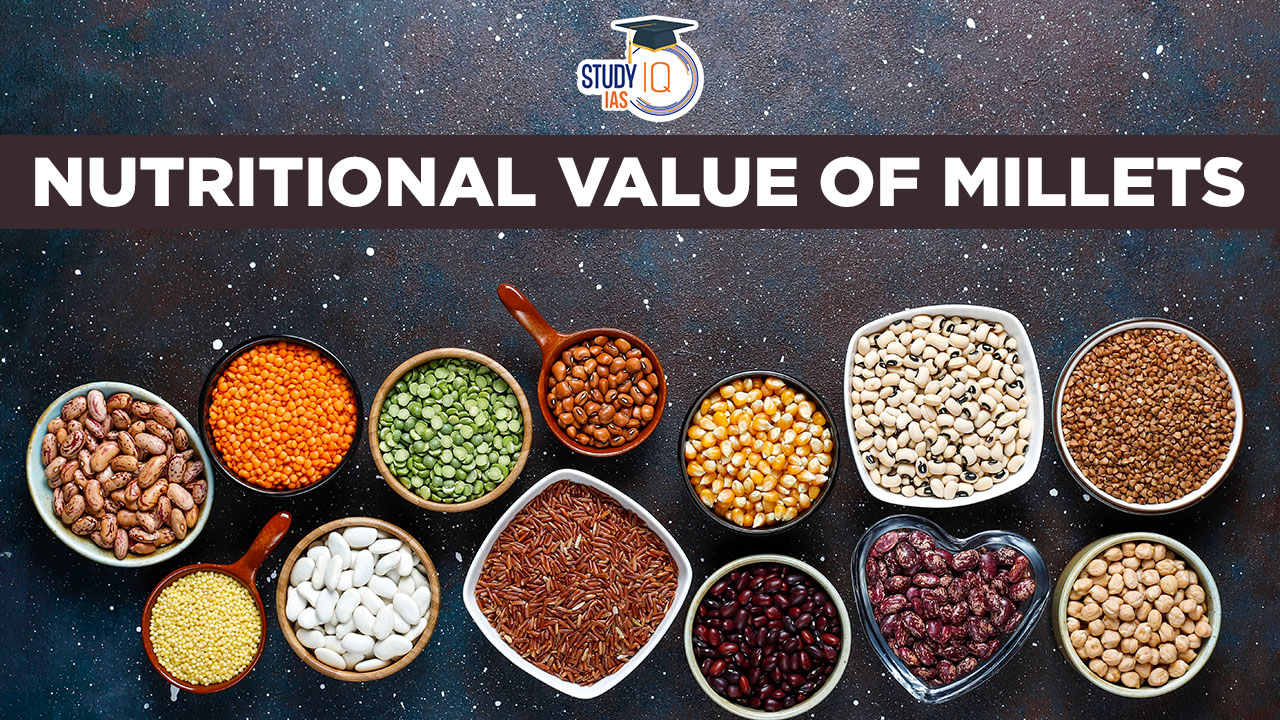Table of Contents
Context: The UN Food and Agriculture Organization (FAO) has declared 2023 to be the ‘International Year of Millets’.
More on the News
- There is a growing popularity of millets in India due to their ability to grow in environmental conditions that are becoming more common due to the climate crisis, as well as their low input requirements and high nutritional density.
- This will be helpful for India to handle the challenges of food security now and in the future.
- However, the consumption of millets faces a threat from grain-processing, which has already overtaken India’s major food crops.
What are Millets?
- Millets are a type of cereal crop that are cultivated worldwide, particularly in the tropical parts of Africa and Asia.
- They are essentially grasses and include various varieties such as pearl millet (Cenchrus americanus), barnyard millet (Echinochloa utilis), finger millet (Eleusine coracana), and foxtail millet (Setaria italica).
- Other grasses such as sorghum, adlay millet, and teff are also grouped together with millets.
- Millets have been cultivated in the Indian subcontinent for at least five millennia.
- According to the Agricultural and Processed Foods Development Authority, India is the world’s largest producer of millets.
- In 2021-2022, the country accounted for 40.51% of the world’s pearl millet production and 8.09% of sorghum.
- Within the country, pearl millet made up 60% of all the millet production, sorghum 27%, and ragi 11%.

Climatic Conditions for the growth of Millets:
- Climate: Millets are adapted to grow in arid and semi-arid regions with low and erratic rainfall. They can tolerate a range of temperatures, typically from 30°C to 35°C.
- Soil Type: Millets have a wide adaptability to different soil types, from poor to fertile, and can tolerate some degree of alkalinity.
- Availability of Water: Millets require less water compared to other grains and can grow in regions with as little as 250-300mm of rainfall. This makes them a suitable crop for regions facing water scarcity and drought-like conditions.
Why are Millets Sought after?
- Millets are sought after because they have high nutritional value and can grow reliably in harsh environmental conditions that are becoming more common due to the climate crisis.
- Millets are drought-tolerant, adapted to warm weather, and require low moisture, making them particularly efficient consumers of water.
- They can grow well in loamy soil and can thrive on marginal land in upland and hilly regions.
- Millets also have an advantage over crops like rice and maize, which require more water and are more vulnerable to drought-like conditions.
- As a result, millets are becoming increasingly popular, particularly in countries like India where they can help address food security challenges.

Nutritional Value of the Millets & where they are stored?
- The nutritional content of millets includes carbohydrates, proteins, fibre, amino acids, and various minerals.
- Different millet varieties have different nutrient profiles.
- For example, pearl millet -one of the oldest cultivated varieties has been found to have higher protein content than rice, maize, and sorghum, while being comparable to that of barley.
- Foxtail millet is rich in the amino acid lysine; finger millet has more crude fibre than wheat and rice; proso millet has a significant amount of the amino acids leucine, isoleucine, and methionine;
- Overall, millets have been found to be important sources of micronutrients and phytochemicals.
Storage of Nutrition
- Each millet kernel consists of three major parts, called pericarp, endosperm, and germ.
- The pericarp has an outer covering called the husk. The husk and the pericarp together protect the kernel from inhospitable conditions, disease, and physical damage.
- The endosperm is the largest part of the kernel and its ‘storage’ centre. It has a protein covering called the aleurone.
- The endosperm is relatively poor in mineral matter, ash and oil content but a major contributor to the kernel’s protein (80%), starch (94%) and B-complex vitamins (50-75%). Similarly, pearl millet has a relatively larger germ, which is rich in oil (32%), protein (19%) and ash (10.4%) plus over 72% of the total mineral matter.
- However, the availability of delicious products, knowledge about their nutritional value, and accessibility are crucial factors in including millets in people’s diets.
Does Processing affect these Nutrients?
- Processing and preparing millets can affect nutrients in three ways – enhance them, suppress/remove them, and ignore them.
- Removing the husk and outer coverings can reduce the phytic acid and polyphenol contents, and also remove crude and dietary fiber.
- Milling and sieving can make the flour more digestible and visually attractive but also reduce nutrient content due to the loss of bran.
- Germination and fermentation have been found to improve the overall nutritional characteristics of millets.
Effects of Polishing
- Polishing is the process whereby the outer layers of the grain, including the bran and the germ, are removed.
- As with other grains, polishing millets can lead to nutrient loss.
- The longer the polishing process, the more protein, fat, and fiber contents are removed.
- Example: Polishing barnyard millet for up to three minutes with a rice polisher does not result in significant nutrient loss.
- Polishing rice removed 60-80% of iron, magnesium, phosphorus, potassium, and manganese in both indica and japonica varieties.
- The loss of bran also compromised the grains’ fiber content.
- While polishing is considered desirable for taste, texture, and longer shelf-life, it can significantly reduce the nutritional value of millets.
India and Millets
- In India, millets are mainly a kharif crop.
- Production: India is the largest producer of millet in the world with a share of 41% in 2020, as per FAO.
- Nine types are grown as kharif crops in over 20 States in the country.
- Rajasthan, Karnataka, Maharashtra and Andhra Pradesh are the leading producers.
- For the year 2021-22, about 16 million tonnes millets have been produced in India, which is about 5 percent of the national food grain basket.
- Bajra has the highest market share, followed by jowar.
- MSP for Millets: The government declares a Minimum Support Price (MSP) for jowar, bajra and ragi only.
- Main millet states:
- Jowar is mainly grown in Maharashtra, Karnataka, Rajasthan, Tamil Nadu, Andhra Pradesh, Uttar Pradesh, Telangana, and Madhya Pradesh.
- Bajra is mainly grown in Rajasthan, Uttar Pradesh, Haryana, Gujarat, Madhya Pradesh, Maharashtra and Karnataka.
- Consumption patterns: In the latest available NSSO household consumption expenditure survey, less than 10 per cent of rural and urban households reported consumption of millets.
- State-wise: Gujarat (jowar and bajra), Karnataka (jowar and ragi), Maharashtra (jowar and bajra), Rajasthan (bajra), and Uttarakhand (ragi).


India’s efforts to Promote Millets
- Budget push 2023-24: To make India a global hub for ‘Shree Anna’ (millets), the Indian Institute of Millets Research, Hyderabad will be supported as the Centre of Excellence for sharing best practices, research and technologies at the international level.
- Rebranding as ‘Nutri-Cereals’: Millets were earlier referred to as “coarse cereals” or “cereals of the poor”. The Union government renamed these as “nutri-cereals” owing to their high nutritional value.
- National year of millets: The Union government declared 2018 as the ‘national year of millets’ to trigger an increase in demand.
- Initiative for Nutritional Security through Intensive Millets Promotion (INSIMP): A sub-scheme of Rashtriya Krishi Vikas Yojana (RKVY) between 2011 and 2014. The scheme aims to catalyze increased production of millets in the country.
- Millets under PDS:
- Under the National Food Security Act (NFSA), 2013, eligible households are entitled to get rice, wheat, and coarse grain at Rs 3, Rs 2, and Re 1 per kg respectively.
- There is a need to shift the focus of distribution programs from basic calories to provide a more diverse food basket to improve the nutritional status of pre-school children and women of reproductive age.
- NFSM: Under the National Food Security Mission (NFSM), nutritious cereal component for Millets
is being implemented in 212 districts of 14 States. - POSHAN Mission: Millet has also been included under POSHAN Mission campaign.
- Start-Ups: India has more than 500 start-ups in millet value additional food chain. The
government’s Indian Institute of Millets Research has incubated 250 startups.
International Year of Millets (IYOM) 2023
- In 2021, the United Nations General Assembly (UNGA) adopted a resolution to
declare 2023 as the International Year of Millets.- The proposal was moved by India and was supported by 72 countries.
- Significance:
- IYOM will provide an opportunity to increase global production and promote millets as a major component of the food basket.
- Recently, the FAO launched the IYOM in Italy and highlighted that the promotion of millets aligns with Sustainable Development Goals (SDGs) — 1, 3, 8, 12, 13 and 15.
- Political significance for India: Millet is grown mainly in low-income and developing countries in Asia and Africa and are part of the food basket of about 60 crore people across the globe.
- By proposing the resolution to celebrate 2023 as the International Year of Millets, India pitched itself as a leader of this group.
- This is similar to the Indian initiative on the 121-nation International Solar Alliance.
Way forward to Enhance Millet Adoption
- Enhancing demand: It is important to educate consumers about the nutritional benefits of millets that can contribute to their immunity and health, especially in the post-pandemic scenario.
- Input availability: Ensuring the availability of planting material can be achieved by establishing a range of seed banks to provide diverse options for millet cultivation.
- Strengthening Millet Farmers’ Bargaining Power: Small and marginal millet farmers’ bargaining power can be strengthened both in domestic and global markets by linking them with the Electronic Agricultural National Market (e-NAM) and establishing farmer producer organizations (FPOs).
- Maintaining diversity: Different varieties of millets, suited to different agro-ecological zones, should be promoted. Therefore, introducing MSP for different varieties is imperative.


 Kavachi Volcano: Location, Features, Eru...
Kavachi Volcano: Location, Features, Eru...
 Dark Eagle Hypersonic Missile System: Fe...
Dark Eagle Hypersonic Missile System: Fe...
 UPPSC Recruitment 2026 Notification Out ...
UPPSC Recruitment 2026 Notification Out ...

























